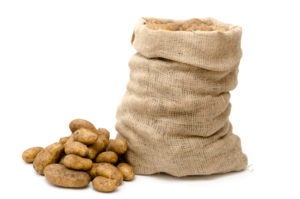
Because potatoes are ubiquitous, people hardly notice them.
Mostly white in color and always bland in flavor, they fade into the culinary background. But where would soups, stews, casseroles, gratins, side dishes and French fries be without them?
Besides being a filling comfort food, potatoes are quite complex. Not every potato is good for every recipe. And some potatoes may harm you.
Low in moisture and high in starch with rough skins, russet potatoes are ideal for baking, mashing, French fries and latkes.
Red bliss potatoes, new potatoes, fingerlings and most of the petit varieties have moister flesh and thinner skins. They hold their shape during cooking, so they are great for roasting, potato salads, gratins and simply boiling.
With their buttery color, Yukon Golds are the ultimate all-purpose potato. Fluffy and light, they’re not too crumbly, nor are they dense. Boil, mash and roast them. They are an asset in soups, stews and casseroles.
Although many people peel and discard potato skins, they contain more nutrients than the flesh inside. They are full of fiber, vitamin B and calcium. Since potatoes are a vegetable, actually an underground tuber, they are gluten-free.
On the safety front, potatoes retain more pesticides than most produce, so it’s best to buy organic. When potatoes are green, they have been exposed to light and have begun to produce chlorophyll. If this greening is pale and only skin deep, peel them to remove the green layers. But if the green color is dark and goes deeper into potatoes, they could be toxic and should not be eaten.
If your potatoes exhibit a few small sprouts, simply cut them out. But if the sprouts have formed an extensive network, the potatoes could be toxic so it’s best to discard them.
If after peeling potatoes, you see dark spots, don’t worry. This means the potatoes got bruised, but are perfectly healthy to eat. Scrape off the dark spots if they bother you.
There are at least 5,000 potato varieties and probably double that number of recipes calling for this versatile tuber. Believe it or not, potatoes are this country’s most consumed produce item. Americans eat nearly 50 pounds per person per year. That’s a lot of popularity for overlooked spuds.
Roasted Fingerling Potatoes | Pareve
Serves 4-6
Equipment: 11-inch-by-17-inch baking pan and parchment paper
1½ pounds fingerling potatoes, on the small side
¼ teaspoon each: onion powder, garlic powder, curry powder and cumin
1 teaspoon thyme
1 teaspoon kosher salt
⅛ teaspoon balsamic vinegar
2 tablespoons olive oil
Preheat your oven to 375 degrees F. Line the baking pan with parchment paper.
Rinse the potatoes under cold water, and drain them on paper towels. Cut them in half lengthwise. Move them to a plastic bag and reserve.
In a small bowl, place the spices, salt, balsamic vinegar and the olive oil. Whisk until well combined. Drizzle the mixture into the plastic bag over the potatoes. With one hand, close the plastic bag, and gently shake it until the potatoes are well coated.
Move the potatoes to the prepared pan. Arrange them cut side down. Roast them for 25-30 minutes, turning once or twice, until crisp. Serve immediately.
Homemade Potato Chips | Pareve
Serves 4-6
Equipment: 2 large frying pans and 16 paper towels, or more if needed
2 pounds russet potatoes
½ cup olive oil, or more, if needed
Kosher salt to taste
Arrange two layers of paper towels on two cookie sheets, about 4 paper towels per cookie sheet.
Rinse the potatoes under cold water, and pat them dry with paper towels. Scrape off the potato skins. Using a sharp knife, slice the potatoes as thinly as possible.
Pour some of the oil into each frying pan. You won’t need the entire ½ cup now. Heat it over a medium flame.
Arrange as many potato slices in each frying pan as will comfortably fit without overlapping. Sprinkle them with a generous amount of salt. When the bottom sides are golden, turn them over. Continue frying until both sides are light brown. Add more oil when needed.
Move the chips to the paper towels to drain, and continue frying until all potato slices are crisp. When the paper towels become saturated with oil, discard them and move the potato chips to a bowl or platter. Line the cookie sheets with fresh paper towels, when needed.
Serve immediately.
Creamy Smashed Potatoes | Pareve
Serves 4-6
⅓ cup olive oil
5 garlic cloves, squeezed through a garlic press
Kosher salt to taste
1 heaping tablespoon capers drained on paper towels
6 Yukon Gold potatoes
In a small saucepan, heat the oil over a medium-low flame. Sauté the garlic and sprinkle it with salt. When the garlic is fragrant, remove it from the flame. Reserve.
Peel the potatoes and cut them into quarters. Boil them until they are soft in the center. Drain them in a colander, and move them to a large mixing bowl. Drizzle the olive oil mixture over the potatoes.
With a fork or masher, gently smash the potatoes until lumpy and retaining some shape. (This is not a mashed potato recipe.) Add the capers, and gently mix them into the potatoes. Add more salt, if needed.
Serve immediately.
Italian Boiled Potatoes with Garlic Oil | Pareve
Serves 4-6
¼ cup olive oil
4 garlic cloves, minced
Kosher salt to taste
2 tablespoons chives, chopped
10 new potatoes, peeled
In a small saucepan, heat the olive oil over a medium-low flame. Add the garlic and salt.
Sauté until the garlic is fragrant. Remove the pan from the heat, and add the chives. Stir briefly. Reserve.
Scrape the skin off the potatoes. Cut the potatoes into bite-sized pieces. Boil them until soft in the center. Drain them in a colander. Move them to a serving bowl. Drizzle the potatoes with the olive oil mixture, and gently stir to combine. Add more salt, if needed. Serve immediately.



